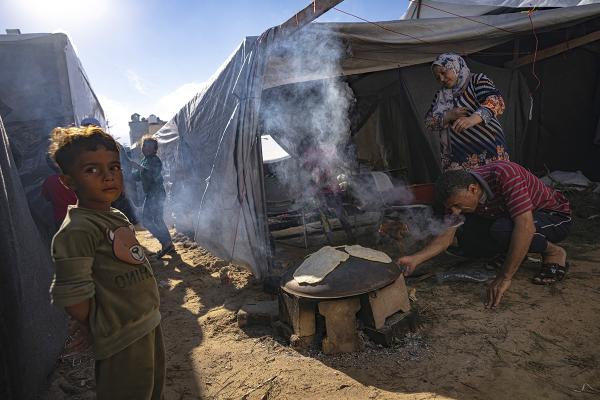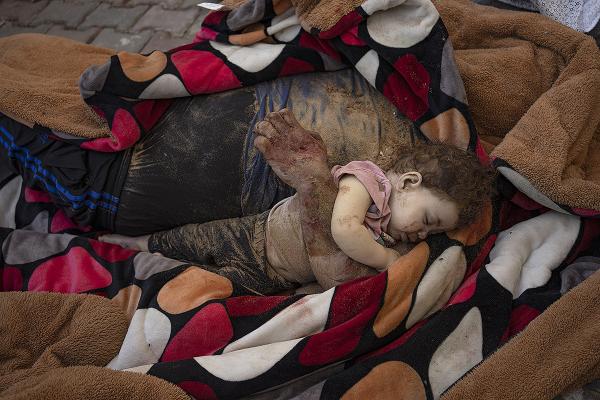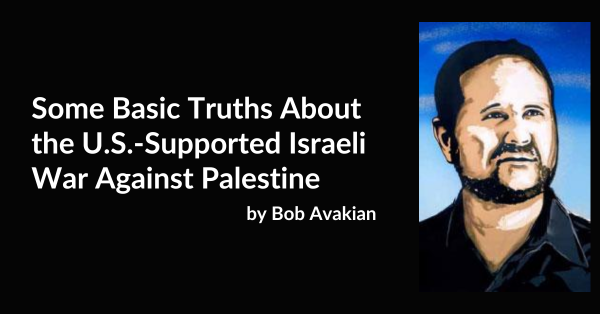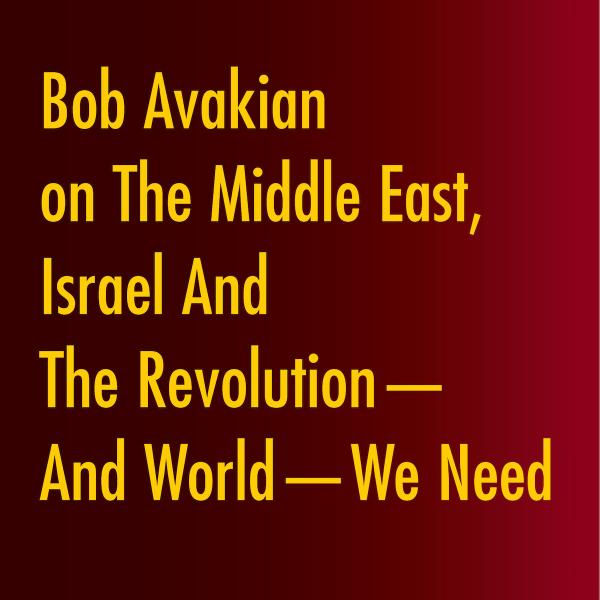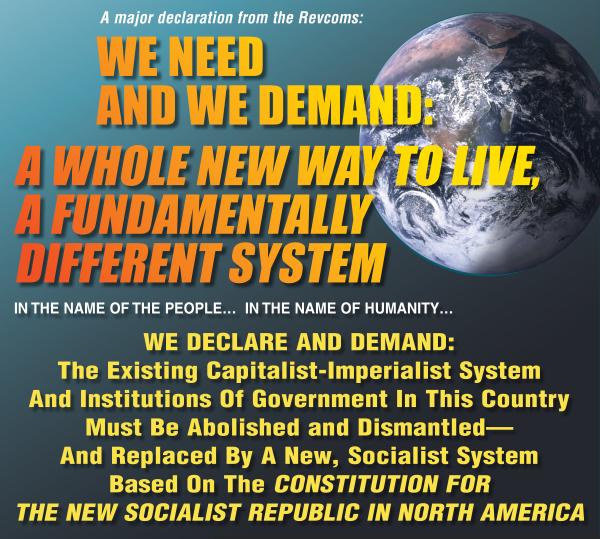On Friday, November 24, Israel “paused” its genocidal onslaught against the Palestinian people in Gaza (even as its vicious “ethnic cleansing” in the West Bank intensified. As we go to press, this “pause” is holding, with Israel agreeing to observe the truce so long as ten hostages a day are being released by Hamas.
What does the “pause” change? Let’s start with what it does not change:

Every day the search for bread and water in Gaza intensifies. Here, one day after Israeli airstrike, Palestinians scour a street market in Jabaliya refugee camp.
Photo: AP
This “pause” does not change the fact that the Israeli government has vowed to totally destroy Hamas, the ruling political organization in Gaza. Nor does it change the fact that the Prime Minister of the Israeli government, Benjamin “Netan-Nazi” Netanyahu, has called on Israel to emulate the Biblical figure Saul's near total genocide against the people of Amalek, or that the defense minister has called every Palestinian an “animal” and said they should be treated like animals (that is, presumably slaughtered).
Indeed, “Netan-Nazi” told his cabinet on the eve of the truce, "There is a lot of nonsense out there to the effect that after the pause to return our hostages, we will stop the war. Then let me make it clear: We are at war—and will continue the war. We will continue the war until we achieve all of our war aims: To eliminate Hamas, return all of our hostages and our missing, and ensure that there is no element in Gaza that threatens Israel." (Given that Israel is now jailing people—including even Israelis—for the mildest dissent, think about what that last phrase means.)
The pause does not change the fact that for seven weeks the Palestinian people in Gaza have been denied water, fuel, medicines, food and other necessities of modern life. The pause has not magically returned any of the 1.7 million Palestinian refugees (nearly three out of every four Gazans!) to their homes. The pause did not enable these refugees to stop sleeping in the streets, far from their homes, without the basic requirements for human existence.
The “pause” did not magically rebuild the destroyed hospitals of Gaza—The war has knocked 27 of 35 hospitals across Gaza out of operation, and the remaining ones are only partly operational according to the World Health Organization.
Nor did the “pause” bring back to life the over 5,000 children that the Israeli military has murdered.
Nor has it stopped Biden’s request for over $14 billion in military aid to Israel, on top of the $3 billion Israel already got this year.
The “pause” did not change the horror of the conditions in Gaza.
As the truce went into effect, an Associated Press reporter described Gaza as an “uninhabitable moonscape.” Whole neighborhoods have been turned to rubble and dust, with uncounted bodies underneath, and the stench of death filling the air. Homes, schools and hospitals have been blasted by airstrikes and scorched by tank fire. Some buildings in the northern half of Gaza are still standing, but half are battered shells. Nearly one million Palestinians have fled the north, including Gaza’s largest concentration of people, Gaza City, as ground combat intensified.
Israel said it had bombed more than 15,000 targets before the current cease-fire, often targeting densely populated areas with U.S.-made 2,000-pound bombs that can flatten an apartment tower. As a measure of how much non-combatant civilians are the targets of Israel’s massive bombing of Gaza, more than twice as many women and children have already been reported killed in Gaza than in Ukraine after almost two years of Russian attacks, according to United Nations estimates.
As we post this, most of Gaza’s 2.3 million survivors are crowded into the southern portion of the territory, where Israel has ordered them to flee, without resources to survive. Many are sleeping in the streets under tarps. They lack the most basic requirements for human existence. According to the U.N., water production in Gaza has been reduced by Israeli bombing to less than 12% of what it was October 7.
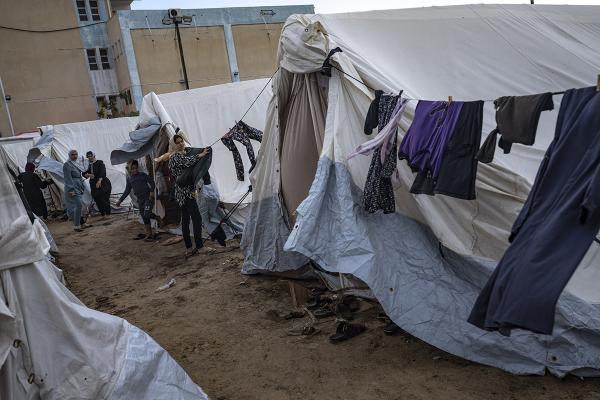
Palestinians displaced by the Israeli bombardment of the Gaza Strip at a U.N. displacement camp in Khan Younis, November 19, 2023. Photo: AP
More than one million people are sleeping in U.N. schools-turned-shelters. Many of those driven from northern Gaza hoped to seize on the short break in Israel’s bombing to return home to check on family they have lost touch with, to bury their dead or to retrieve a few belongings from their homes. But the hundreds of thousands who evacuated from northern Gaza to the south were warned not to return in leaflets dropped by Israel. Israeli troops occupy much of the north, including Gaza City. Two people attempting to return to their homes in the north were shot and killed by Israeli troops and at least another 11 were wounded.
Sofian Abu Amer told a reporter why he risked the attempt to reach his home in Gaza City. “We don’t have enough clothes, food and drinks,” he said. “The situation is disastrous. It’s better for a person to die.”
The “aid” provided by the pause is little more than a cruel joke.
Because of 15 years of Israeli blockades that crippled Gaza’s agriculture, fishing, water purification, construction, and other industries, people in Gaza have survived on imported and donated food and other necessities. Before October 7, nearly 10,000 truckloads of commercial and humanitarian commodities, excluding fuel, entered Gaza monthly, according to the UN. That amounts to about 330 truckloads every day.
Which puts into perspective the obscenity of “allowing” an estimated 50 trucks a day if the truce is extended for four days. A representative of the Palestinian Red Crescent Society (the Islamic equivalent of the Red Cross), told Al Jazeera this was nothing but a “drop in the ocean.”
What is being called a “truce,” or a “pause,” is not really a pause in a meaningful sense. It is a suspension of bombing, for the moment. And allowing a trickle of aid in, not through the numerous Israel-Gaza border crossings, but only through the Rafah crossing that connects the south of Gaza with Egypt.
But it is no pause in the misery, suffering, and death.
What the pause did do was to “buy time” for the combatants.
We don’t know the motivations and inner decision-making of the main “players” in this conflict. But we can take a look at how these different players have been using the pause in the context of what they’ve been doing and saying, and get a better sense of the real dynamics beneath.
Netanyahu has used this pause in order to begin to bring back some of the 200 hostages taken by Hamas in its October 7 raid on Israel, and to at least make a show of satisfying increasing demands within Israel to prioritize the return of the hostages over the prosecution of the war—while making clear his intent to continue the elimination of Hamas.
Israel may also hope to at least temporarily quiet some of the outrage around the world, especially within its chief patron the U.S., while also—in the words of the New York Times—attempting “to glean new intelligence during the pause, and so make plans for its next phase of the war.” They may use this pause to assess whether or how to change their tactics.
Hamas has “taken the measure” of at least some Israeli military capabilities, and now has a chance to regroup and fortify against what will likely be an Israeli onslaught once the pause ends. The pause also allows Hamas to free some of the thousands of political prisoners held by Israel, through exchanging some of its hostages.
For the U.S. and the Biden administration, which worked to set this up, the pause gives the appearance of “seeking peace” at a time when those it sees as its “base of support” are sharply divided over Biden’s all-out backing for Israel. This struggle has created serious problems for the Democrats, with this split reaching even into important government agencies and the staffs of Democratic elected congressional representatives. The pause also enables the U.S. to step things down at least temporarily while it deals with many other challenges internationally—especially from Russia in Ukraine, and China in a more overall sense.
Right now, hopes are being stoked that this “pause” will lead to a cease-fire and then some kind of resolution. Yet these facts remain:
Netan-Nazi’s government remains publicly committed to a total decimation of Hamas and the installation of some kind of yet-to-be-determined new regime in Gaza.
Hamas took a major gamble with its October 7 attack and is now fighting for its existence.
The U.S. cannot afford to allow either a major defeat for Israel, nor does it want ongoing war and “instability” in this strategic region of the world at a time in which they face major challenges from other imperialists (again, Russia and, even more strategically, China).
We can't predict where all this will go, but one thing IS clear:
The struggle against the U.S.-Israeli genocidal war must not be “paused” but must be stepped up: broadened, deepened, and more clearly targeted against not only Israel but the whole system of U.S. imperialism which backs it and benefits off it.
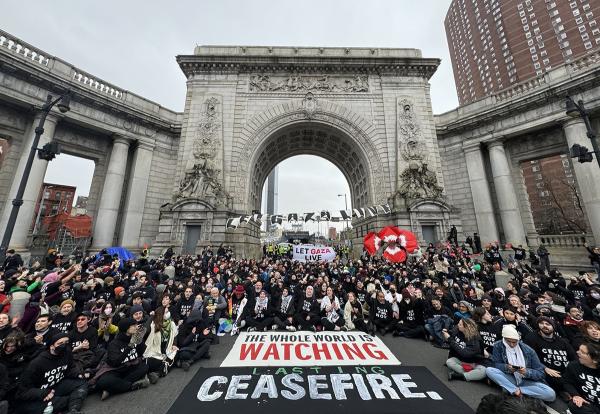
New York City, Jewish Voice for Peace shuts down Manhattan Bridge, November 26, 2023. Photo: @jvplive
“If our children do not die from war, they will die from the cold of winter and hunger.”
Israel has systematically bombed, choked, and crippled Gaza’s already fragile medical care infrastructure, and systematically destroyed water, sewage, and shelter.
Under the pretense that it harbored a Hamas “command-and-control center” (a claim backed by Biden and the U.S.), Israel bombed, fired missiles into, and stormed Gaza’s largest hospital, Al-Shifa in Gaza City. Israel arrested or detained hospital administrators, and drove out staff, patients (including babies in incubators), and people seeking shelter at the hospital; horrific war crimes. Josef Federman, an Associated Press reporter, was among those taken on a closely confined “tour” of “evidence” of the supposed Hamas command-and-control center at Al-Shifa. He reported that what the Israeli military presented was at best “a far cry from the elaborate command center officials originally said was underneath Shifa.” BBC international editor Jeremy Bowen wrote, “The evidence Israel has produced, so far, I do not believe to be convincing in terms of the kind of rhetoric Israelis were using about the set-up at the hospital, which suggested this was a nerve centre for the Hamas operation.”

Palestinians wounded by Israeli bombardment of the Gaza Strip in a makeshift treatment room at al Aqsa Hospital, November 23, 2023. Photo: AP
“Israel’s repeated attacks damaging hospitals and harming healthcare workers, already hard hit by an unlawful blockade, have devastated Gaza’s healthcare infrastructure,” said A. Kayum Ahmed, special adviser on the right to health at Human Rights Watch. “The strikes on hospitals have killed hundreds of people and put many patients at grave risk because they’re unable to receive proper medical care.”
What was a health crisis has escalated into a catastrophe. In mid-November, the rainy season arrived in Gaza. Throughout southern Gaza, children sleeping under plastic tarps shiver in wet clothes, while flooded and churned-up roads and open land turn to mud. Overflowing sewage and flooded streets are rapidly spreading diseases.
Respiratory diseases were already the sixth-most common cause of death in the Gaza Strip prior to the outbreak of Israel’s genocidal bombing last month. Some 70,000 people are suffering severe breathing problems now. Tens of thousands of cases of diarrhea are reported, with half the victims are children under five years old according to the World Health Organization. The cause is overwhelmingly contaminated drinking water. Other out-of-control outbreaks include thousands of skin rashes, scabies and lice, and chickenpox.
The Israeli newspaper Haaretz reported that an unnamed “western ambassador” to Israel warned that Gaza is facing a “medical catastrophe.”
Speaking to Al Jazeera, a Palestinian man at a U.N. shelter in Gaza pointed to the genocidal dimension of this: “If our children do not die from war, they will die from the cold of winter and hunger.”
